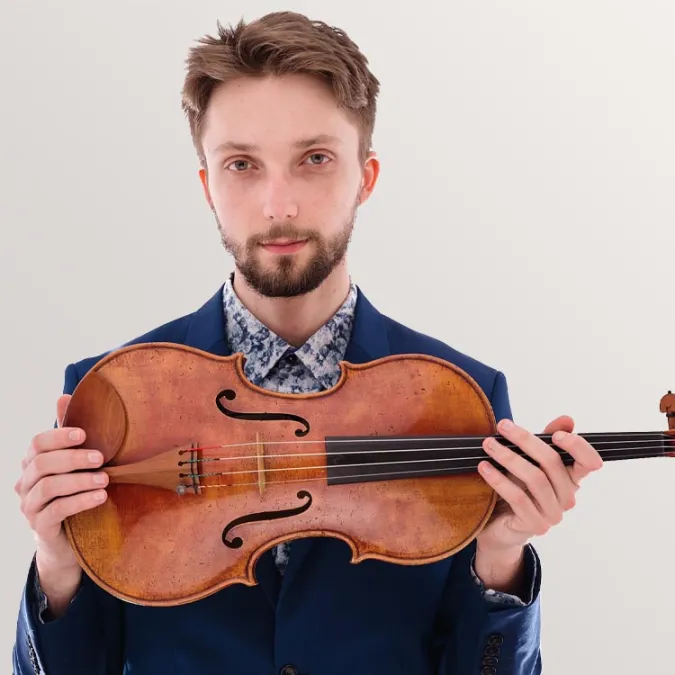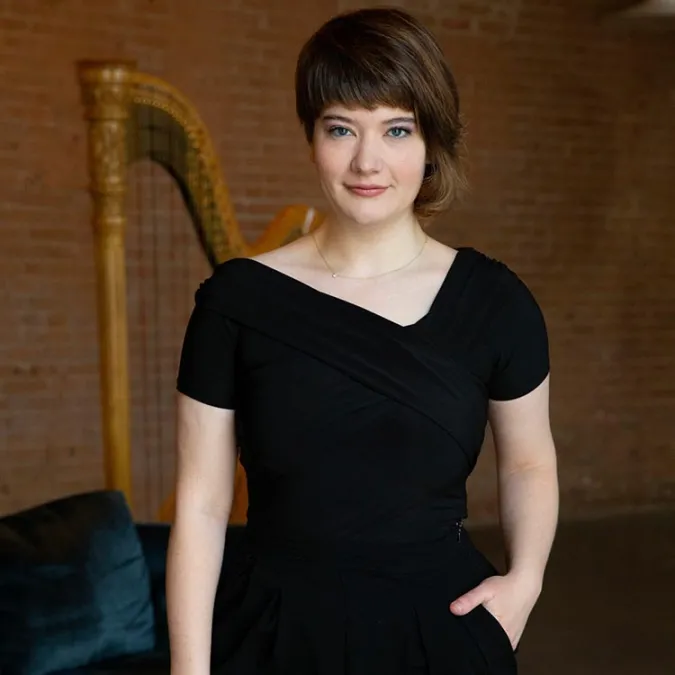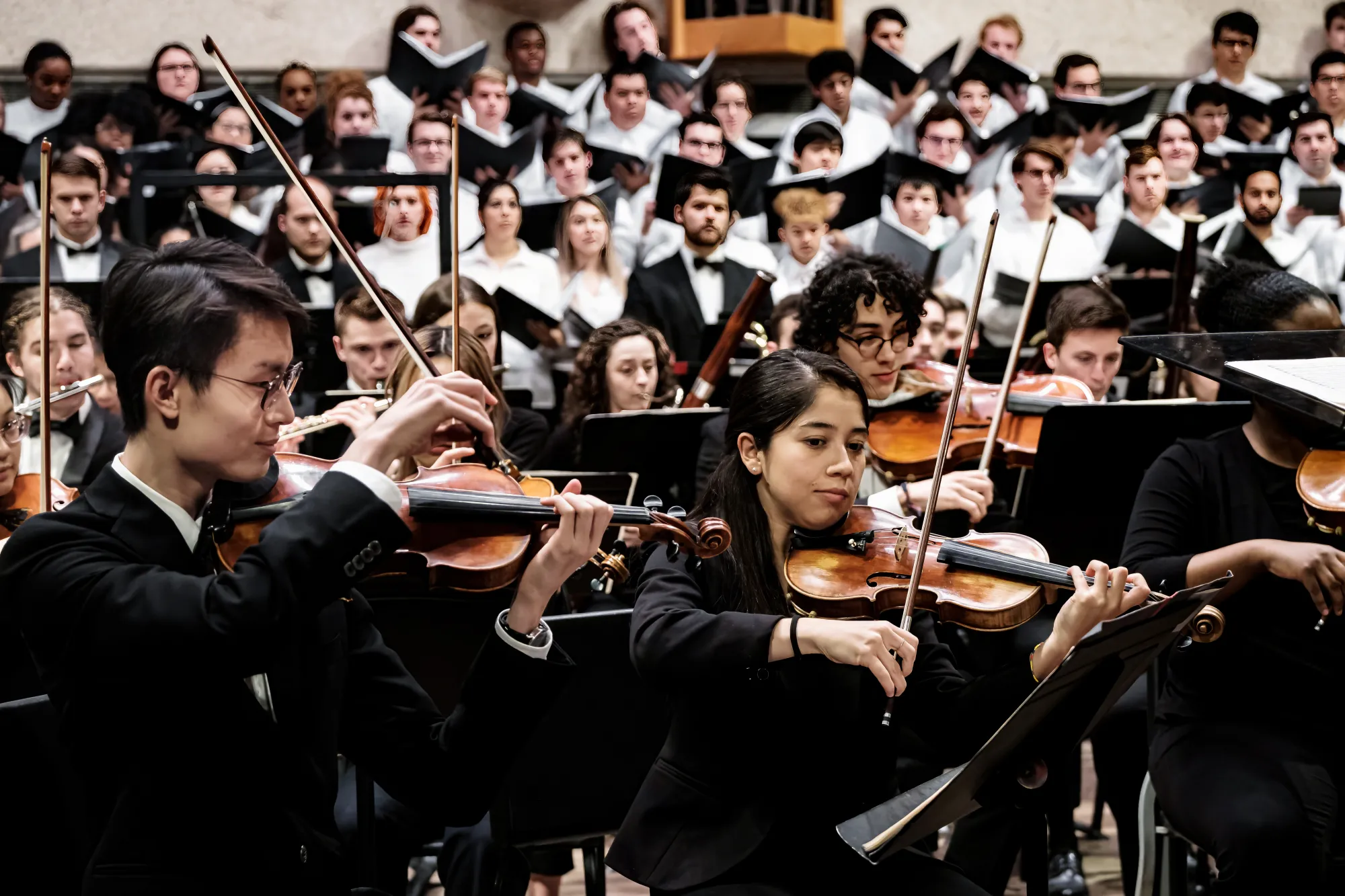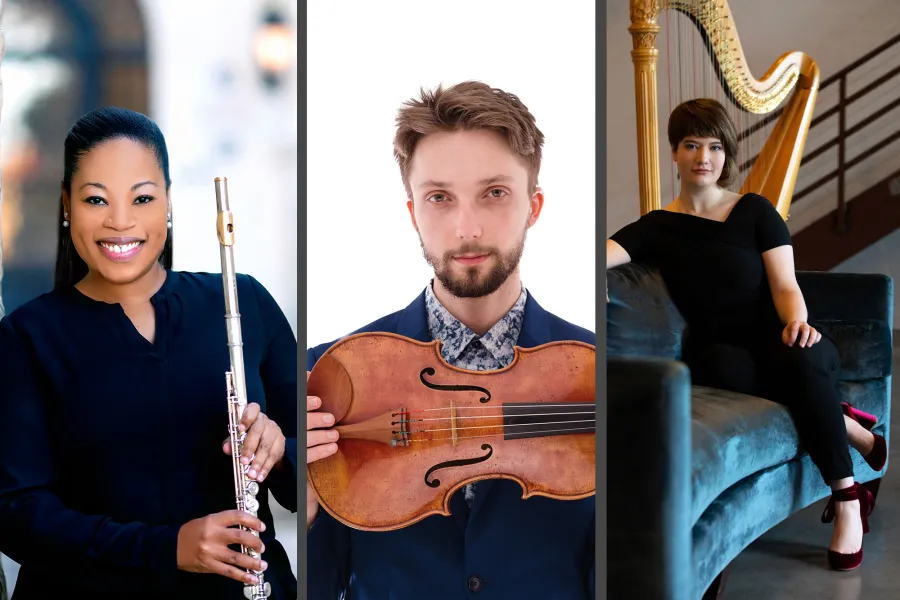This concert will last about 80 minutes with one intermission.
Please silence your electronic devices.
Photography, video, or recording of any part of this performance is prohibited
Program
Airat Ichmouratov
Fujin’s Dream, op. 58
Fred Onovwerosuoke
Trio for Flute, Viola and Harp
world premiere commissioned by Ebonee Thomas
Mornings at the Barnyard
First Fruits
A Nubian Dance Meditation 2.0
Dragonflies in the Meadows
intermission
Tōru Takemitsu
And Then I Knew ‘Twas Wind
Claude Debussy
Sonata for Flute, Viola and Harp, L. 137
Pastorale: Lento, dolce rubato
Interlude: Tempo di Minuetto
Finale: Allegro moderato ma risoluto
About the Program
Airat Ichmouratov
Fujin’s Dream, op. 58
Composed 2018
Duration 13 minutes
Airat Ichmouratov is a clarinetist, conductor, and composer who has become one of Canada’s most prolific classical voices, with nearly a hundred works for orchestra and chamber music to his name. Writing in a Romantic tradition, his music is known for its lyricism and color. In Fujin’s Dream, Ichmouratov turns to Japanese mythology, portraying Fujin, the god of wind — at once destructive and life-giving. Fujin’s Dream portrays both the destructive power of typhoons and the gentler breezes that clear the skies. Fujin, often depicted with a great “windbag,” is said to have blown away the clouds at the world’s creation. Scored for flute, viola, and harp, an ensemble famously used by Debussy, the piece moves between turbulence and serenity, offering a dreamlike portrait of the wind’s many faces.
– Wilhelm Magner
Fred Onovwerosuoke
Trio for Flute, Viola and Harp
Born 1960
World Premiere
Duration 15 minutes
Works by Fred Onovwerosuoke (“FredO”) have been featured in audio recordings, films, documentaries and radio, including Robert De Niro's film, The Good Shepherd, William-Chapman Nyaho's album ASA, Hymes/Hollister's album, African Art Music for Flute, Hudson/Henderson's album Libera, Peter Henderson’s and Twenty-Four Studies in African Rhythms, to mention just a few. His numerous awards include multiple ASCAP Awards, American Music Center Award, Meet-The-Composer Award, and Brannen-Cooper Brothers Award. His collection, Songs of Africa published by Oxford University Press quickly became a favorite among choral directors across the globe. His book Twenty-four Studies in African Rhythms for Piano (AM Publishers), is considered one of the most in-demand African-rhythm influenced piano studies known, and Twelve African Songs for Solo Voice & Piano, is a cherished compendium for singers. His recently commissioned work for orchestra and chorus, A Triptych of American Voices, continues to generate new conversations about classical music programming and social justice. Of his Trio for Flute Viola and Harp The composer writes:
In four descriptively titled movements, Trio for Flute, Viola, and Harp charts new horizons of rhythmic, melodic, and harmonic sensibilities, all inspired by the composer’s travels and research. Movement I, "Mornings at the Barnyard," is whimsical, rowdy, and playful; an opening movement evoking the spirited chaos of early morning at the barn with all its rustic charm and rhythmic vitality. Movement II, "First Fruits," essentially inspired by many musical evenings spent with griots and bards in the Sene-Gambia subregion of West Africa, this movement channels oral traditions and communal storytelling through music, praise-singing, and minstrelsy. Movement III, "A Nubian Dance Meditation 2.0," a reflective reimagining of an earlier solo guitar work, this movement explores ancient Abyssinian courtship dance traditions from northeastern Africa: demure and introspective, it offers a contemplative lens on wedding rituals. Movement IV, "Dragonflies in the Meadows," is basically a spirited finale with intense polyrhythmic flair. Though each movement was conceived independently, together they take performers and listeners on a sonic safari — a kaleidoscopic journey through distant lands, illuminating rhythm, song, and dance from multicultural vantage points.
Tōru Takemitsu
And Then I Knew ’Twas Wind
Born 1930
Died 1996
Composed 1992
Duration 15 minutes
And Then I Knew ’Twas Wind is a hauntingly delicate work that reflects Tōru Takemitsu’s lifelong fascination with color, silence, and perception. Takemitsu, largely self-taught, became one of Japan’s most celebrated composers and a profound voice in 20th-century music. His work bridges traditions, blending Western impressionism with Japanese aesthetics, the spaciousness of ma (the meaningfulness of silence and space), and touches of American minimalism. The title comes from Emily Dickinson’s poem “Like Rain it sounded till it curved, / And then I knew ’twas Wind.” The poem evokes a moment of perception, when the indistinct becomes clear, and Takemitsu mirrors this transformation in sound. The music unfolds in a single movement with distinct sections, flowing like wind itself, without climax or resolution, but with a suspended sense of time. Like Debussy’s Sonata for Flute, Viola, and Harp, a work Takemitsu deeply admired. This piece received its premiere in Boston. In fact, it may be heard as both homage and continuation: a dialogue with Debussy’s lyricism, transformed through Takemitsu’s own sensibilities. Tone color, resonance, and silence are at the heart of the work, making the listener as aware of what is not played as of what is heard.
– Ebonee Thomas
Claude Debussy
Sonata for Flute, Viola, and Harp, L. 137
Born 1862
Died 1918
Composed 1915
Duration 20 minutes
Also known simply as the Debussy Trio, the Sonata for Flute, Viola, and Harp is a luminous work from the composer’s late period. Written in 1915 during the First World War, this sonata reflects both personal and artistic transformation: the music carries the melancholy of wartime and illness, yet shimmers with grace, elegance, and innovation. The sonata was the second of a planned set of six for various chamber combinations: a project Debussy undertook as a tribute to 18th-century French composers such as Couperin and Rameau. Sadly, only three were completed before his death: the Violin Sonata, the Cello Sonata, and the Trio Sonata. Among these, the Sonata for Flute, Viola, and Harp stands out for its unique and groundbreaking instrumentation. Originally conceived for flute, oboe, and harp, Debussy ultimately replaced the oboe with the viola, seeking a warmer, more blended timbral palette. The viola serves as a perfect intermediary between the bright, airy tones of the flute and the resonant plucked textures of the harp. This instrumentation was almost unprecedented at the time, only one known earlier trio for this combination exists, Terzettino (1905) by Théodore Dubois. Debussy's decision not only redefined the possibilities of this ensemble but also inspired generations of composers to write for this now-iconic trio. The Sonata is a masterclass in Debussy’s impressionist language. He employs modal scales, non-traditional harmonic progressions, and delicate, evocative timbral colors to create a sound world that bridges the 18th and 20th centuries. The opening Pastorale movement begins with a lyrical, melancholic flute melody reminiscent of Syrinx and Prelude to the Afternoon of a Faun, imbued with tenderness and introspection. The second movement, Tempo di Minuetto, is a graceful homage to the minuet form, light-hearted and dance-like in character. The final movement, Allegro moderato, bursts forth with rhythmic vitality and sweeping gestures, bringing the sonata to a spirited close. In this trio, Debussy distills his late style: refined, intimate, and forward-looking. It is a poignant reminder of his enduring ability to find beauty amidst personal and collective turmoil, and to forge new paths within tradition.
– Ebonee Thomas
About the Artists
Ebonee Thomas

Thomas is the second flute and piccolo for The Dallas Opera, and has previously served as principal flute of the Knoxville Symphony, principal flute of the Florida Grand Opera, and second flute of the Houston Symphony. She spends her summers as a flutist at Lakes Area Music Festival and Music in the Mountains, and has been guest principal with symphonies and opera companies across the country. A passionate pedagogue, Thomas served as a member of the board of the Greater Dallas Youth Orchestras and is on the national advisory board of the Memphis Youth Symphony Program. She is also currently the piccolo committee chair for the National Flute Association. An avid chamber musician, Thomas has worked with the Austin Chamber Music Society and Voices of Change, a new music ensemble in Dallas. She recently made her debut performance with the ensembleNEWSRQ, a contemporary ensemble highlighting living and underrepresented composers. Thomas received her Bachelor of Music in flute performance from Southern Methodist University and her Master of Music from New England Conservatory of Music. She is a Burkart Piccolo Artist and plays on a Burkart Elite piccolo and 998 flute.
Wilhelm Magner

The first violist in 111 years of the competition to be awarded the Prix d'Europe in 2022, Wilhelm's solo engagements in 2023-2024 include recitals and chamber music concerts in Canada, the United States and Poland. Wilhelm is interested in expanding the viola repertoire and has transcribed many works by composers such as Bach, Lutoslawski, Paganini and Waxman for the viola. In addition to performing, he has given masterclasses in the USA and Canada. He holds a master's degree in viola performance from Yale University in the class of professor Ettore Causa. Previously, he studied with Professor André Roy and Natalia Kononova. He was named to CBC Music's "30 under 30" list in 2022. Wilhelm has appeared in many summer festivals, including Yellowbarn, Gstaad Menuhin Festival, Kneisel Hall, the Young Artists Program of the National Arts Center, and the Orford Music Academy. In his spare time, Wilhelm enjoys playing chess and listening to music. Wilhelm is a recipient of the Sylva Gelber Foundation award. He plays a Ryan Soltis, Nelson, 2023 viola and an Ouchard bow generously loaned by CANIMEX INC. of Drummondville (Quebec), Canada.
Emily Levin

Harpist Emily Levin has forged a multifaceted career as soloist, orchestral musician, chamber collaborator, and advocate for new music. Principal harp with the Dallas Symphony Orchestra since 2016, Levin has served as guest principal harp with the Boston Symphony Orchestra, Chicago Symphony Orchestra, Los Angeles Philharmonic, and the Houston Symphony. As soloist and chamber musician, she has performed at venues throughout North America and Europe, including Carnegie Hall, National Sawdust, the Ojai Music Festival, the Kimmel Center, and the Festspiele Mecklenburg-Vorpommern. In 2021, she founded GroundWork(s), an initiative commissioning 52 American composers—one from each state, plus Washington, DC, and Puerto Rico—to write new works for harp. Commissions have included works by Angé lica Negró n, Reena Esmail, Michael Ippolito, Aaron Holloway Nahum, and Jerod Impichchaachaaha’ Tate. Levin is the only American to receive top prizes at two of the most prestigious international harp competitions: the USA International Harp Competition and the International Harp Contest in Israel. She was also a winner of the 2016 Astral Artists National Auditions and was named the Classical Recording Foundation's 2017 Young Musician of the Year for her debut album, Something Borrowed. Levin is adjunct associate professor of harp at Southern Methodist University.
Upcoming Events

Mahler Symphony No. 2, Resurrection
Symphony Orchestra & Combined Choirs
Leah Crocetto, soprano
Sophio Dzidziguri, mezzo soprano
One of the most beloved symphonies in the canon, Mahler's "Resurrection" symphony boasts a large orchestra, mezzo and soprano soloists, and similarly to Beethoven's 9th Symphony, a large choir in the final movement. For this performance, the Butler School's Concert Chorale and University Chorus ensembles will join forces; they will be joined by Butler School alumni singers and community choral singers from around Austin.
Tuesday, March 31, 8:00 p.m.
Long Center for the Performing Arts
SCHUBERTIADE
With Anton Nel & Friends
Monday, November 3, 7:30 p.m.
Bates Recital Hall
SYMPHONY ORCHESTRA
Saturday, November 8, 7:30 p.m.
Bates Recital Hall
BUTLER HOLIDAY CONCERT
Featuring Chamber Orchestra And Choirs
Saturday, December 6 & Sunday, December 7
Bates Recital Hall
MIRÓ QUARTET
With Wilhelm Magner, Viola
Friday, January 30, 2026, 7:30 p.m.
Bates Recital Hall
Event Details
$10 – 20
All University of Texas at Austin students are allowed one free ticket as long as they are available. Student tickets must be picked up at the Box Office with valid student I.D. Seating is unassigned.
If you are a patron with specific seating needs, please email tickets@mail.music.utexas.edu and we will reserve ADA seating for you.


